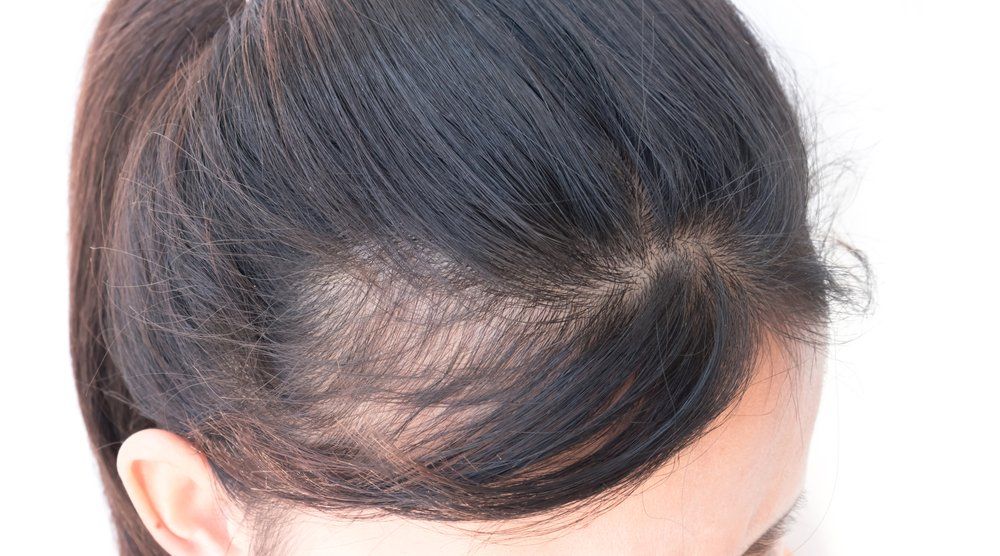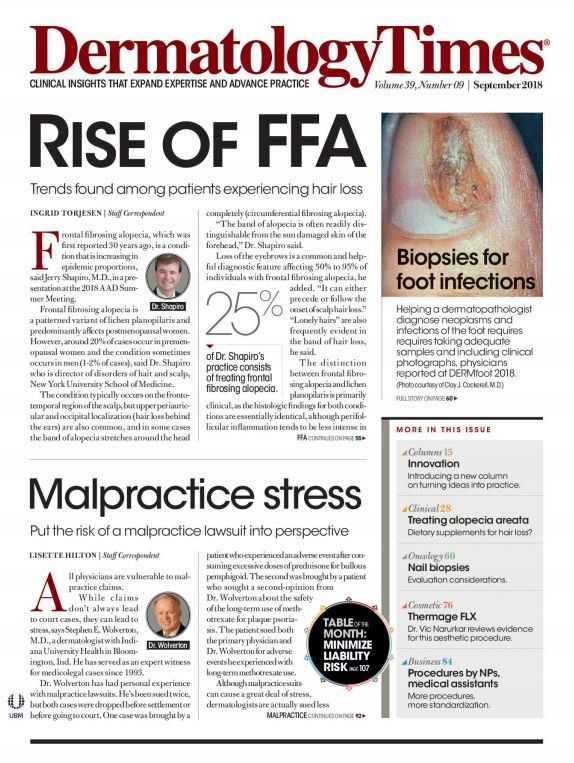- Acne
- Actinic Keratosis
- Aesthetics
- Alopecia
- Atopic Dermatitis
- Buy-and-Bill
- COVID-19
- Case-Based Roundtable
- Chronic Hand Eczema
- Chronic Spontaneous Urticaria
- Drug Watch
- Eczema
- General Dermatology
- Hidradenitis Suppurativa
- Melasma
- NP and PA
- Pediatric Dermatology
- Pigmentary Disorders
- Practice Management
- Precision Medicine and Biologics
- Prurigo Nodularis
- Psoriasis
- Psoriatic Arthritis
- Rare Disease
- Rosacea
- Skin Cancer
- Vitiligo
- Wound Care
Publication
Article
Dermatology Times
Frontal fibrosing alopecia from rare to frequent
Author(s):
Frontal fibrosing alopecia is a condition that is increasing in epidemic proportions, says Jerry Shapiro, M.D., in a presentation given at the 2018 AAD Summer Meeting.
Frontal fibrosing alopecia is increasing in epidemic proportions, said Jerry Shapiro, M.D., at the 2018 AAD Summer Meeting. (©MRAORAOR/Shutterstock.com)

Frontal fibrosing alopecia, which was first reported 30 years ago, is a condition that is increasing in epidemic proportions, says Jerry Shapiro, M.D., in a presentation given at the 2018 AAD Summer Meeting.
Frontal fibrosing alopecia is a patterned variant of lichen planopilaris and predominantly affects postmenopausal women. However, around 20% of cases occur in premenopausal women and the condition sometimes occurs in men (1-2% of cases), said Dr. Shapiro who is director of disorders of hair and scalp, New York University School of Medicine.
The condition typically occurs on the frontotemporal region of the scalp, but upper periauricular and occipital localization (hair loss behind the ears) are also common, and in some cases the band of alopecia stretches around the head completely (circumferential fibrosing alopecia).
“The band of alopecia is often readily distinguishable from the sun damaged skin of the forehead,” Dr. Shapiro said.
Loss of the eyebrows is a common and helpful diagnostic feature affecting 50% to 95% of individuals with frontal fibrosing alopecia, he added. “It can either precede or follow the onset of scalp hair loss.” “Lonely hairs” are also frequently evident in the band of hair loss, he said.
The distinction between frontal fibrosing alopecia and lichen planopilaris is primarily clinical, as the histologic findings for both conditions are essentially identical, although perifollicular inflammation tends to be less intense in frontal fibrosing alopecia than in lichen planopilaris.
Treatments include: antimalarials, tetracyclines, intralesional cortisone, topical tacrolimus, cortisone and minoxidil. There is a tiered approach to managing these cases. Twenty five percent of Dr. Shapiro’s practice consists of frontal fibrosing alopecia. The emphasis on therapy is follicular rescue as the follicles are permanently destroyed. This is a scarring process.
The use of certain products with sunscreens has been associated with an increased likelihood of having frontal fibrosing alopecia, Dr. Shapiro said. One study based on questionnaires about exposure to a wide range of lifestyle, social and medical factors found that twice as many women with the frontal fibrosing alopecia group had used a sunscreen compared with controls - a difference that was highly significant. Women with frontal fibrosing alopecia also showed a trend towards more frequent use of facial moisturizers and foundations, although this just failed to reach statistical significance.
A subsequent study in men found a similar association with the use of facial moisturisers and sunscreens.
Studies with men and women suggest the conclusion that there may be an association between frontal fibrosing alopecia and the use of facial moisturisers with sunscreens.”
The sunscreen ingredients that may be implicated are the ones that were approved by the FDA in 1988 as the condition was first reported in 1994. This association still needs to be proven more conclusively.
REFERENCE
Shapiro J. U021 - Managing Frontal Fibrosing Alopecia, Saturday, July 28; 7:30 AM - 8:30 AM. AAD Summer Meeting, July 26-29, 2018, Hyatt Regency Chicago, Chicago, IL. https://www.aad.org/scientificsessions/sam2018/SessionDetails.aspx?id=11949
i. N. Aldoori K. Dobson C.R. Holden A.J. McDonagh M. Harries A.G. Messenger. Frontal fibrosing alopecia: possible association with leaveâon facial skin care products and sunscreens; a questionnaire study. British Journal of Dermatology 2015; 175 (4): 762-767.
https://doi.org/10.1111/bjd.14535
ii. A. Debroy Kidambi K. Dobson S. Holmes D. Carauna V. Del Marmol A. Vujovic M.R. Kaur A. Takwale P. Farrant C. Champagne M. Harries A.G. Messenger. Frontal fibrosing alopecia in men: an association with facial moisturizers and sunscreens. British Journal of Dermatology 2017; 177 (1): 260-261.
https://doi.org/10.1111/bjd.15311

Newsletter
Like what you’re reading? Subscribe to Dermatology Times for weekly updates on therapies, innovations, and real-world practice tips.





















